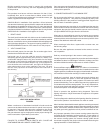
18
1. CONVENTIONAL INSTALLATIONS
All modern hydronic type boilers are exceptionally fast heating units.
The low water volumes in relation to ring rates require special
attention to water ow rates for smooth, efcient operation. These
considerations for the A. O. Smith copper heat exchanger boilers
are covered below.
Conventional 20
0
F (10
0
C) drop in systems for a fully loaded boiler
will maintain the following approximate ow rates:
MODELS GPM (LPM)
HW-300 23 (87)
HW-399 30 (114)
HW-420 35 (132)
HW-520 39 (148)
HW-610/670 46 (175)
Figure 7 on page 14 shows a typical installation of the boiler with pipe
sizing and circulator selected by the installer to provide adequate
water ow whenever the boiler is ring.
In a system with several large zones of which any might be smaller
than approximately 1/3 of the system should include a hydronic
balancer as shown in Figure 7. The balancer connects between
the system supply and the return line before the circulator inlet.
Adjustment of the balancing cock should permit adequate boiler ow
rate when only the smallest zone is in operation.
Attention should be given to balancing inputs and water ow rates
where wide variations of system ow rates can occur.
The recommended minimum ow rates that will result in approximately
50
0
F (30
0
C) temperature rise across the boiler are as follows:
MODELS GPM (LPM)
HW-300 9 (34)
HW-399 12 (45)
HW-420 14 (53)
HW-520 16 (61)
HW-610 18 (69)
HW-670 20 (76)
If system ow rate is unknown, or if zoning creates extreme variations
in ow rates, the boiler should be installed as shown in Figure 11 on
this page for A. O. Smith LINEAR-TEMP installations.
2. LINEAR-TEMP INSTALLATIONS
A. New Installations
A. O. Smith LINEAR-TEMP systems have been designed to provide
efcient, trouble-free operation of the boiler sizes covered in this
manual with any of the following conditions:
a. Unknown system ow rate
b. Varying ow rate as with zoned systems
c. Multiple boiler installations
Figure 11 on this page shows piping and accessory arrangement
for a boiler pumped independent of the primary system mains. Pipe
sizing and boiler loop pump selection data are shown in Table 6 for
several different temperature rises across the boilers.
ONE BOILER INSTALLED
INDEPENDENT OF THE PRIMARY SYSTEM
FIGURE 11.
Total heating requirements for the building can be supplied by a
series of boiler loops all connecting to a common pipe joining the
system supply and return mains. The supply and return branches of
each boiler loop must join the common pipe only a short nipple length
apart. The different sets of branches should be installed reasonably
close together, but not necessarily to the short nipple length as
required for the supply and return of each set. These branches may
be made with tees or with welded connections.
The installer is reminded that the total boiler ow rates need not
match the system ow rate.
TABLE 6.
PUMP AND PIPE SIZING DATA
(PIPING FROM TEES IN MAIN TO BOILER BRANCHES)
Model Temp. Rise °F (°C) G.P.M. *Pump Size Pipe Size
HW-300
20 (10)
30 (15)
30 (15)
40 (20)
23
15
15
11
1-1/2" PR
150
125
100
2"
1-1/2"
1-1/4"
1"
HW-399
20 (10)
35 (15)
40 (20)
40 (20)
30
20
15
15
60-13
1-1/2" HV
150
125
2"
1-1/2"
1-1/2"
1-1/4"
HW-420
20 (10)
35 (15)
40 (20)
40 (20)
32
21
16
16
60-13
1-1/2" HV
150
125
2"
1-1/2"
1-1/2"
1-1/4"
HW-520
20 (10)
20 (10)
35 (17)
40 (20)
39
26
23
20
2-1/2"
1-1/2" HV
1-1/2" HV
150
2-1/2"
2"
1-1/2"
1-1/2"
HW-610/670
20 (10)
30 (15)
35 (17)
40 (20)
51
34
29
25
60-13
2-1/2"
2"
1-1/2" HV
3"
2-1/2"
2"
1-1/2"
NOTE: Pipe loop sizes and pump selections based on
50 equivalent feet of pipe and ttings.
*All pump sizes listed are B & G model numbers.
SYSTEM INSTALLATIONS


















